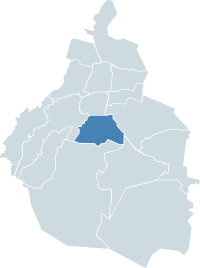Coyoacán
| Coyoacán, D.F. | ||
|---|---|---|
| Delegación | ||

Fountain depicting the drinking coyotes that gave the town its name at the Jardín Centenario
|
||
|
||
 Coyoacán within the Federal District |
||
| Country | Mexico | |
| Federal entity | D.F. | |
| Established | 1928 | |
| Named for | Pre-Columbian city | |
| Seat | Jardín Hidalgo No. 1 Col. Villa Coyoacán, C.P. 04000 | |
| Government | ||
| • Jefe delegacional | Mauricio Alonso Toledo Gutiérrez (PRD) | |
| Area | ||
| • Total | 54.12 km2 (20.90 sq mi) | |
| Elevation[1] | 2,256 m (7,402 ft) | |
| Highest elevation | 2,420 m (7,940 ft) | |
| Population 2010 | ||
| • Total | 620,416 | |
| • Density | 11,000/km2 (30,000/sq mi) | |
| Time zone | Central Standard Time (UTC-6) | |
| • Summer (DST) | Central Daylight Time (UTC-5) | |
| Postal codes | 04000–04980 | |
| Area code(s) | 55 | |
| Website | www |
|
Coyoacán ([koʝoaˈkan]) refers to one of the 16 boroughs (delegaciones) of the Federal District of Mexico City as well as the former village which is now the borough’s “historic center.” The name comes from Nahuatl and most likely means “place of coyotes,” when the Aztecs named a pre-Hispanic village on the southern shore of Lake Texcoco which was dominated by the Tepanec people. Against Aztec domination, these people welcomed Hernán Cortés and the Spanish, who used the area as a headquarters during the Spanish conquest of the Aztec Empire and made it the first capital of New Spain between 1521 and 1523. The village, later municipality, of Coyoacan remained completely independent of Mexico City through the colonial period into the 19th century. In 1857, the area was incorporated into the Federal District when this district was expanded. In 1928, the borough was created when the Federal District was divided into sixteen boroughs. The urban sprawl of Mexico City reached the borough in the mid 20th century, turning farms, former lakes and forests into developed areas, but many of the former villages have kept their original layouts, plazas and narrow streets and have conserved structures built from the 16th to the early 20th centuries. This has made the borough of Coyoacan, especially its historic center, a popular place to visit on weekends.
To distinguish it from the rest of Coyoacán borough, the former independent community is referred to as Villa Coyoacán or the historic center of the borough. Consisting now of 29 blocks, it is one of the oldest neighborhoods in Mexico City, located 10 km south of the Zocalo (main square) of Mexico City. This area is filled with narrow cobblestone streets and small plazas, which were laid out during the colonial period, and today give the area a distinct and bohemian identity. The area is filled with mostly single family homes, which were former mansions and country homes built between the colonial period to the mid 20th century. The Project for Public Spaces ranked the neighborhood as one of the best urban spaces to live in North America in 2005 and is the only Mexican neighborhood on the list. This area was designated as a "Barrio Mágico" by the city in 2011.
...
Wikipedia

